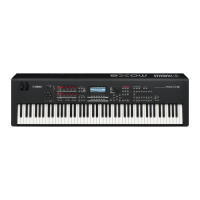PERF SONG PATTERN MIX MASTER REMOTE UTILITY
QUICK SET
FILEVOICE
MOX6/MOX8 Reference Manual
Song Mode
Song Play
[F1] PLAY
[F2] GROOVE
[F3] TRACK
[F6] CHAIN
Song Record
Song Record Standby
[F1] SETUP
[F2] VOICE
[F3] ARP ED
[F5] CLICK
[F6] ALL TR
During Song Recording
[F1] SETUP
[F3] REST
[F4] TIE
[F5] DELETE
[F6] BAK DEL
Arpeggio Edit
[F1] COMMON
[F2] TYPE
[F3] MAIN
[F4] LIMIT
[F5] PLAY FX
[F6] OUT CH
Song Edit
[F1] CHANGE
[F2] VIEW FLT
[F4] TR SEL
[F5] INSERT
[F6] DELETE
Song Job
[F1] UNDO/REDO
[F2] NOTE
[F3] EVENT
[F4] MEAS
[F5] TRACK
[F6] SONG
Supplementary Information
83
QtzStrength (Quantize Strength)
Determines the offset value for “QtzStrength” in the [F5] PLAY FX display. This parameter is applied to all parts.
Settings: -100 – +0 – +100
VelocityRate
Determines the offset value for “VelocityRate” in the [F5] PLAY FX display. This parameter is applied to all parts.
Settings: -100 – +0 – +100
GateTimeRate
Determines the offset value for “QtzTimeRate” in the [F5] PLAY FX display. This parameter is applied to all parts.
Settings: -100 – +0 – +100
Swing
Determines the offset value for “Swing” in the [F5] PLAY FX display. This parameter is applied to all parts.
Settings: -120 – +0 – +120
These are the same as in the Arpeggio Edit display (page 27) of the Voice mode.
These are the same as in the Arpeggio Edit display (page 27) of the Voice mode. Please note that the “Tempo”
parameter is not in the MAIN display of the Song mode. Instead, the following parameter is available in the display. The
tempo setting for arpeggio is same as the tempo setting in the Song Play display.
VoiceWithARP (Voice with Arpeggio)
Each Arpeggio type is assigned a specific Voice best suited to the type. This parameter determines whether or not the
appropriate Voice registered to each Arpeggio type is assigned to the edited Part. When set to “on,” the appropriate
Voice is assigned to the edited Part in place of the currently assigned Voice. When set to “off,” the appropriate Voice is
not assigned to the edited Part. The currently assigned Voice is maintained.
These are the same as in the Arpeggio Edit display (page 28) of the Voice mode.
These are the same as in the Arpeggio Edit display (page 28) of the Voice mode.
OutputSwitch
When this is set to on, Arpeggio playback data is output via MIDI.
Settings: off, on
TransmitCh (Transmit Channel)
Determines the MIDI transmit channel for Arpeggio playback data. When set to “KbdCh,” the Arpeggio playback data is
output via the MIDI Keyboard Transmit Channel ([UTILITY] [F6] MIDI “KBDTransCh”).
Settings: 1 – 16, KbdCh (Keyboard Channel)
[F2] TYPE
[F3] MAIN
[F4] LIMIT
[F5] PLAY FX (Play Effect)
[F6] OUT CH (Output Channel)

